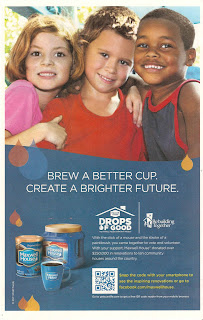 I’m always a little bit chary of the many contests that offer a donation to charities that get the most votes, or Likes, or pageviews, or Tweets. Pepsi Refresh and American Express Members Project are prominent, but hardly the only examples of these kinds of Crowd-Sourced Cause Marketing promotions.
I’m always a little bit chary of the many contests that offer a donation to charities that get the most votes, or Likes, or pageviews, or Tweets. Pepsi Refresh and American Express Members Project are prominent, but hardly the only examples of these kinds of Crowd-Sourced Cause Marketing promotions.Maxwell House, a coffee brand from Kraft, does its own version of this Crowd-Sourced Cause Marketing called Drops of Good in partnership with the cause Rebuilding Together.
My problem is that such promotions so often become beg-a-thons, and pathetic ones at that. Since promotional money is always tight, only a relatively small handful of humble supplicants ever get funded. After 2.1 million votes, Maxwell House’s top grant was $10,000, which it gave to five communities. Another five got $5,000.
And because of the winners-take-all approach of most of these promotions, a charity that gets even a few hundred less votes than the finalists is basically out of luck with nary a consolation prize.
Now you could argue that a charity’s act of rallying support from its constituents for such promotions probably teaches the staff lessons about persuasion and friend-raising and cements goodwill among supporters.
But that’s a little like kissing your mom; comforting, but hardly romantic.
What if, as a consolation prize, Amex, Pepsi, Maxwell House and the many others left online a searchable list of all the causes who have been nominated over the years and included the details, some kind of comment feature, links and contact info?
It would serve as a kind of seal of approval, an imprimatur the causes could promote around. Just as a film will tout an actor who has been nominated for an Academy Award, a cause could promote the fact that it was nominated for a Pepsi Refresh prize.
The sponsor would have to puzzle over the questions of how long to leave it up, how to allow changes to entries, logo usage, what verbiage they’d permit nominated charities to use in promotions, etc.
The value to the charities would be modest. Maybe some Internet link-love from the sponsor and the occasional referral. But it would be better than nothing, which is what currently comes to those who finish out of the money.
But for the sponsor leaving the list up allows it to be in the company with hundreds or even thousands of causes.
And that’s the very essence of cause marketing.
Comments